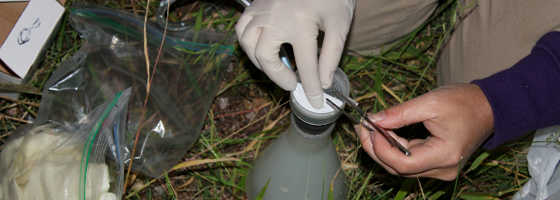University of Idaho researchers monitor amphibians with eDNA

When researchers from the University of Idaho set out to track amphibians, they ran into a problem.
“One of the big issues with trying to monitor amphibians is that they can be difficult to find,” said Katherine Strickler, a research scientist of fish and wildlife resources at UI. “If you are not there at the exact time, you can miss them.”
So, Idaho researchers turned to a new method for biologically detecting which species call a habitat home. They sample bodies of water and test them for environmental DNA unique to each species of fauna.
Environmental DNA results from any bit of matter an animal leaves in an ecosystem, from eggs, to molted skin, to feces or any other cell. Strickler said eDNA persists up to three weeks ofter animals leave the water, giving scientists a greater window for biological detection.
Collecting eDNA is less stressful for amphibians, which can be sensitive to dipnetting and other survey techniques.
The method is incredibly precise and should not produce false positives, as long as samples remain uncontaminated. UI researchers identify sequences of DNA specific to one amphibian that differentiate them from others that are very similar. Then they collect a water sample from an area where they suspect a particular amphibian would live. Samples are preserved in ethanol so that bacteria don’t break down the DNA.
Researchers separate and replicate a specific eDNA sequence from the samples and run it through a sequencing machine to verify a species match.
 Researchers collect their water samples with a simple rig consisting of a vacuum flask, filter funnel and a Pegasus Athena peristaltic pump.
Researchers collect their water samples with a simple rig consisting of a vacuum flask, filter funnel and a Pegasus Athena peristaltic pump.
They pump four 250 milliliter samples from each pond or four 1 liter samples from each stream. A special filter collects any DNA in the sample.
Strickler said they tested several peristaltic pumps before purchasing the Pegasus model. “The Pegasus is great because it allows us to filter water a lot more quickly, a lot more efficiently and it gives us less wear and tear on our bodies,” Strickler said.
The pump’s compact design also makes it ideal for sampling in remote locations where the scientists have to hike-in equipment.
Strickler and Caren Goldberg, a UI biological research scientist, monitor ecological areas in military bases under a U.S. Department of Defense grant. They’re working in southeast Arizona, Washington state and Florida’s panhandle.
So far they have had success sampling in smaller scale ponds and are working to verify if their sampling method will work in larger bodies of water.
They are using their work to establish a general protocol for eDNA sampling to guide researchers and managers who want to use eDNA to monitor aquatic species.





0 comments